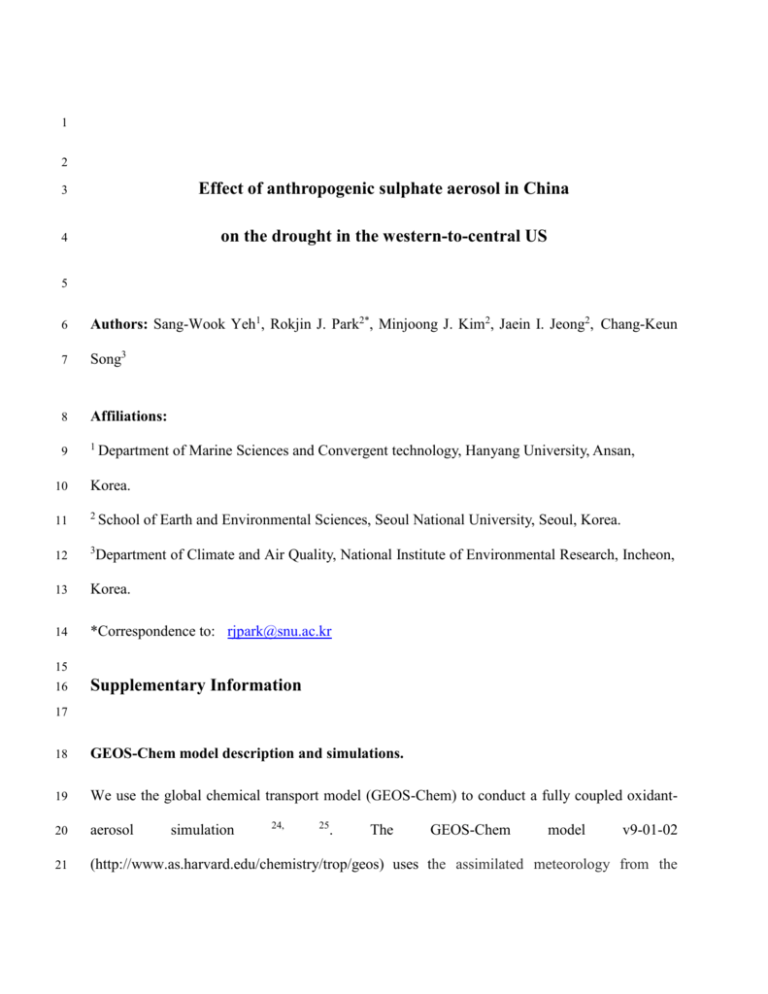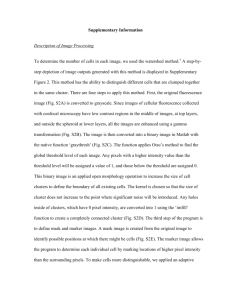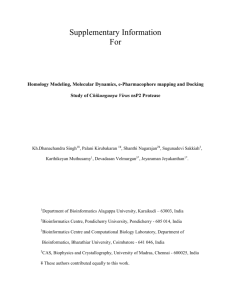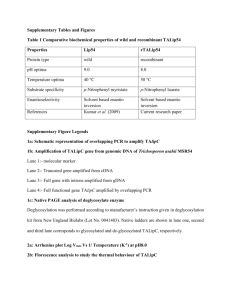Supplementary Information
advertisement

1 2 3 Effect of anthropogenic sulphate aerosol in China 4 on the drought in the western-to-central US 5 6 Authors: Sang-Wook Yeh1, Rokjin J. Park2*, Minjoong J. Kim2, Jaein I. Jeong2, Chang-Keun 7 Song3 8 Affiliations: 9 1 Department of Marine Sciences and Convergent technology, Hanyang University, Ansan, 10 Korea. 11 2 School of Earth and Environmental Sciences, Seoul National University, Seoul, Korea. 12 3 Department of Climate and Air Quality, National Institute of Environmental Research, Incheon, 13 Korea. 14 *Correspondence to: rjpark@snu.ac.kr 15 16 Supplementary Information 17 18 GEOS-Chem model description and simulations. 19 We use the global chemical transport model (GEOS-Chem) to conduct a fully coupled oxidant- 20 aerosol 21 (http://www.as.harvard.edu/chemistry/trop/geos) uses the assimilated meteorology from the simulation 24, 25 . The GEOS-Chem model v9-01-02 22 Modern-Era Retrospective Analysis for Research and Applications National Aeronautics and 23 Space Administration (MERRA NASA) 24 temperature, clouds, and precipitation at a 3-h frequency with a horizontal resolution of 0.5° × 25 0.666° and 72 hybrid pressure-sigma levels extending up to 0.01 hPa. We degrade these 26 meteorological fields to a horizontal resolution of 2° × 2.5° and 47 vertical levels for 27 computational expediency. 16 . The data include winds, convective mass fluxes, 28 GEOS-Chem includes more than 80 species and 300 reactions for detailed O3-NOX- 29 hydrocarbon chemistry coupled with aerosol chemistry. The aerosol simulation includes H2SO4- 30 HNO3-NH3 aerosol thermodynamics 31 with the ISORROPIA II aerosol thermodynamic equilibrium model 32 emission inventories for anthropogenic species where available, including the European 33 Monitoring and Evaluation Program (EMEP) inventory for Europe, the EPA 1999 National 34 Emissions Inventory (NEI99, U.S. Environmental Protection Agency) for the U.S., and 35 otherwise default values from the Global Emission Inventory Activity (GEIA)28 scaled to the 36 simulation years 37 over the Asian domain (60°E–158°E and 13°S–54°N) only 28. The Asian emissions of NOX, SO2, 38 and NH3 are 9.1 Tg N y–1, 18.9 Tg S y–1, and 21.8 Tg N y–1, respectively. We subsequently apply 39 the annual scale factors of the Regional Emission inventory in Asia (REAS) for 1985-2010 29 to 40 the Streets et al. emissions to impose interannual variations in the model. The REAS inventory 41 includes anthropogenic emissions for 1985-2003 estimated based on the fuel combustion and 42 industrial sources and projected emissions after 2004. GEOS-Chem simulations have been 43 applied to a number of air chemistry issues, including important tropospheric aerosols 44 they have been extensively evaluated by comparison against observations in the U.S., Europe, 24, 25 26 , and the formation of these aerosols is computed locally 27 . The model uses national . We use the anthropogenic emissions from the gridded inventory for 2000 25, 26 and 2 45 and Asia. The long-term simulations of sulphate aerosol concentrations exhibit a good agreement 46 with the observations at the EANET sites in Asia 23. 47 48 Relationship of sulphate aerosol, precipitation and atmospheric teleconnections 49 Supplementary Fig. S1A indicates the time series of anomalous precipitation averaged in the US 50 (120W-90W, 30N-40N) during the boreal summer (June-July-August) for the period of 51 1985-2010 using the CMAP precipitation datasets. Supplementary Fig. S2 is the same as in Fig. 52 1A in the main text except the Modern-Era Retrospective Analysis for Research and 53 Applications National Aeronautics and Space Administration (MERRA NASA). Similar to Fig. 54 1A, the regressed geopotential height anomaly shows a zonally elongated atmospheric 55 teleconnection pattern linking the variability of summertime precipitation over southeastern 56 China and the western-to-central US. The anomalous high geopotential over the western-to- 57 central US is evident, which is likely associated with the precipitation decrease in the same 58 region. 59 Supplementary Fig. S3A indicates the differences of zonal (105E-120E) averaged 60 temperature between the two periods (2001-2010 minus 1985-1994) using the NCEP RA2. It is 61 evident that there exists a strong gradient of the zonal temperature in the meridional direction. 62 That is, the zonal temperature in northeastern China is much warmer in the low-level troposphere 63 than that in southeastern China, which is mainly associated with the radiative cooling effect from 64 the enhancement of sulphate aerosol in southeastern China. This leads the weakening in the 65 meridional temperature gradient for 2001-2010 compared to for 1985-1994. In addition, this is 66 also associated with decelerating upper level jet stream at the jet exit region, as indicated by the 3 67 strong negative upper level zonal wind anomaly at 35–45°N (Supplementary Fig. S3B). 68 Subsequently, the secondary circulation induced by jet stream weakening, with rising motion 69 around 20°N~35°N and sinking motion around 45°N, which is consistent with the convergence 70 and divergence field at upper levels (Supplementary Fig. 3C). These secondary circulations are 71 consistent with the precipitation difference in Fig. 2A in the main text. Note that similar results 72 are obtained from using a different reanalysis dataset (not shown here). 73 Supplementary Fig. S4 indicates the regressed precipitation against with the time series 74 of sulphate aerosol averaged in the mid- and southeastern China (105E-120E, 20N-35N). 75 Simple regression analysis indicates that the increase of sulphate aerosol in the eastern China is 76 associated with the increase (decrease) of precipitation amount in southeastern (northeastern) 77 China. 78 Supplementary Fig. S8 displays the difference of summer precipitation simulated in the 79 SST-SO2 run between the two periods (i.e., 2001-2010 minus 1985-94). Unlike the observation, 80 the SST-run and SO2-run (Fig. 2 and Fig. 4 in the main text), the increase of precipitation amount 81 in southeastern China is not significant along with detailed structures. The increase of 82 precipitation amount is very limited in the southeastern China model, which is somewhat 83 different from that in both the SST-run and SO2-run. This may indicate that the contribution of 84 the SST forcing and the regional sulphate aerosol forcing is not linear to increase the 85 precipitation amount in the southeastern China, which should be explored more details. 86 Supplementary Fig. S10B displays the regressed geopotential height anomalies at 500 hPa in the 87 Northern Hemisphere against with the precipitation variability in southeastern China in the SST- 88 run. The structure of atmospheric teleconnection in the SST-run is different compared to the 4 89 SO2-run (Supplementary Fig. S10A). A wave-train signal associated with the precipitation 90 variability in southeastern China is originated from the southeastern China in the SO2-run, which 91 is similar to the observation in spite of some discrepancies in detailed structures. In contrast, that 92 in the SST-run is originated from the western tropical Pacific, which is different from the 93 observation. However, the pattern correlation coefficient between the regressed geopotential 94 heights in the observation (Fig. 1A) and the SO2-run in the entire domain (0-60N, 80E-60W) 95 (i.e., 0.23) is not different from that between the observation and the SST-run (Supplementary 96 Fig. S10B) (i.e., 0.23). 97 We emphasize the anomalous high geopotential height over the western-to-central US in 98 both runs, which is likely associated with the precipitation decrease. The simultaneous 99 correlation coefficient between the precipitation and the geopotential height at 500hPa in the 100 western-to-central US is -0.66, -0.49 and -0.29 in the observation, the SO2-run and the SST-run, 101 respectively. This indicates that the anomalous high geopotential height at 500hPa is associated 102 with the reduction of precipitation in the western-to-central US. Note that the correlation 103 coefficients in the observation and the SO2-run are statistically significant at the 95% confidence 104 level and that in the SST-run is statistically significant at the 85% confidence level. This may 105 indicate that the atmospheric teleconnections associated with both the SST forcing and the 106 regional aerosol forcing are able to modulate the anomalous circulation over the western-to- 107 central US across the Pacific. In other words, the regional aerosol forcing without the SST 108 forcing can lead the changes in atmospheric circulation across the Pacific comparable to the SST 109 forcing only. 110 5 111 112 Community Atmosphere Model simulations. 113 We performed model simulations using the NCAR CAM5 (Community Atmosphere Model 114 version 5) model coupled to the Community Land Surface Model version 4 30. The CAM5 model 115 is based on the finite volume (FV) dynamical core at a 1.9°×2.5° horizontal resolution and with 116 30 vertical levels. For this study, the ocean and ice modules were not fully coupled but were 117 communicated to the atmosphere via an oceanic surface boundary condition, given as mid-month 118 values of sea surface temperature, as well as sea ice fractions over the polar region. The sea 119 surface temperature and the sea ice fractions are time series data constructed by concatenating 120 and interpolating global HadISST data from the Met Office Hadley center 31 to the FV core grids 121 of CAM5. The observed multi-year SST forcing may also serve the purpose of eliminating the 122 uncertainty related to interactions between the atmosphere and the ocean. For aerosol 123 simulations, the CAM5 uses a three-mode version of the modal aerosol model (MAM3), which 124 resolves three different modes: the Aitken, accumulation and coarse modes 125 species in MAM3 include sulphate, primary organic matter, secondary organic matter, black 126 carbon, soil dust, and sea salt aerosols. The internal mixture between species is considered in the 127 MAM3. For sulphate aerosol simulations, simple gas-phase chemistry is used, including DMS 128 oxidation by OH to form SO2, SO2 oxidation by OH to form H2SO4, H2O2 production, and H2O2 129 loss. The total number of transported aerosol tracers in MAM3 is 15. The transported gas species 130 include SO2, H2O2, DMS, H2SO4, and a lumped, semi-volatile organic species. Oxidant 131 concentrations (O3, OH, and HO2) are interpolated from monthly averages taken from 132 simulations by a chemistry-climate model (CAM-Chem) 33. A detailed description of MAM3 can 133 be found in the literature 34. 32 . The aerosol 6 134 In this study, we focus on changes in sulphate aerosols in China and their effects on 135 meteorology. For this purpose, we updated Asian anthropogenic SO2 emissions in CAM5 with 136 the gridded inventory for 2000 over the Asian domain (60°E–158°E and 13°S–54°N) 137 Asian emission of SO2 for 2000 is 18.9 Tg S y–1. Next, we apply annual scale factors of the 138 Regional Emission inventory in Asia (REAS) 139 impose interannual variations in the model. Other aerosols were simulated by the MAM3 in 140 CAM5 32. Supplementary Fig. S5 displays the time series of the concentration of simulated SO42- 141 in the SO2-run. As in Fig. 3D in the main text, the sulphate aerosol concentrations in China are 142 distinct before the mid-1990s and after the early-2000s. 29 27 . The for 1985-2010 to the Streets et al. emissions to 143 To examine the performance of the CAM5 to simulate the atmospheric circulation and 144 the associated precipitation variability in East Asia monsoon during the boreal summer (June- 145 July-August), we first define the East Asian summer monsoon (EASM) index35, which is used by 146 the 147 (http://www.cpc.ncep.noaa.gov/products/Global_Monsoons/Asian_Monsoons/monsoon_index.s 148 html) as follows. NOAA Climate Prediction Center 149 150 where and are the reference climatological winter wind vector and monthly wind vector at 151 point , respectively, and = ( + )/2 is the climatological mean wind vector. In this 7 152 study, 153 taking is = the and climatological = summer wind (for the Northern Hemisphere, ). The norm ||A|| is defined as follows: 154 155 where S denotes the domain of integration. The EASM index well represents the atmospheric 156 circulation associated with the rainfall variability in central-to-southern China during summer. 157 It is found that the spatial pattern in the precipitation variability associated with the 158 EASM index in the SST-SO2 run is not much different from the observation (see Supplementary 159 Fig. S6). To examine the variability in the EASM, we calculate the EASM index in the 160 observation and the SST-SO2 run for 1985-2010 (Supplementary Fig. S7). It is found that the 161 variability of EASM index is reasonably simulated in the SST-SO2 run in comparable to the 162 observation. Note that a simultaneous correlation coefficient between the two time series is 0.52, 163 which is statistically significant at the 95% confidence level. 164 165 166 167 168 169 170 171 172 173 174 175 176 24. Bey, I. et al. Global modeling of tropospheric chemistry with assimilated meteorology: Model description and evaluation. J. Geophys. Res. 106, 23073-23095; DOI: 10.1029/2001JD000807 (2001). 25. Park, R. J., Jacob, D. J., Kumar, N. & Yantosca, R. M. Regional visibility statistics in the United States: Natural and transboundary pollution influences, and implications for the Regional Haze Rule. Atmos. Environ. 40, 5405-5423; DOI: 10.1016/j.atmosenv.2006.04.059 (2006). 26. Park, R. J., Jacob, D. J., Field, B. D., Yantosca, R. M. & Chin, M. Natural and transboundary pollution influences on sulphate-nitrate-ammonium aerosols in the United States: implications for policy. J. Geophys. Res. 109, D15204; DOI: 10.1029/2003JD004473 (2004). 8 177 178 179 180 181 182 183 184 185 186 187 188 189 190 191 192 193 194 195 196 197 198 199 200 201 202 203 204 205 206 207 27. Fountoukis, C. & Nenes, A. ISORROPIAII: A computationally efficient thermodynamic equilibrium model for K+-Ca2+-Mg2+-NH4 +-Na+-SO4 2--NO3 --Cl--H2O aerosols. Atmos. Chem. Phys. 7, 4639-4659; DOI: 10.5194/acp-7-4639-2007 (2007). 28. Streets, D. G. et al. An inventory of gaseous and primary aerosol emissions in Asia in the year 2000. J. Geophys. Res. 108, 8809; DOI: 10.1029/2002JD003093 (2003). 29. Ohara, T. et al. An Asian emission inventory of anthropogenic emission sources for the period 1980-2020. Atmos. Chem. Phys. 7, 4419-4444; DOI: 10.5194/acp-7-4419-2007 (2007). 30. Neale, R. et al. NCAR Tech. Note NCAR/TN-486+STR (NCAR,Boulder CO, 2010). 31. Rayner, N. A. et al. Global analyses of sea surface temperature, sea ice, and night marine air temperature since the late nineteenth century. J. Geophys. Res. 108, 4407; DOI: 10.1029/2002JD002670 (2003). 32. Liu, X. et al. Toward a minimal representation of aerosols in climate models: description and evaluation in the Community Atmosphere Model CAM5. Geosci. Model Dev. 5, 709-739; DOI: 10.5194/gmd-5-709-2012 (2012). 33. Lamarque, J. F. et al. Historical (1850-2000) gridded anthropogenic and biomass burning emissions of reactive gases and aerosols: Methodology and application. Atmos. Chem. Phys. 10, 7017-7039; DOI: 10.5194/acp-10-7017-2010 (2010). 34. IPCC Climate Change 2007: Impacts, Adaptations and Vunerability (eds Parry, M. L. et al.) (Cambridge Univ. Press, UK, 2007). 35. Li, J., & Zeng, Q. A unified monsoon index, Geophy. Res. Letts. 29(8), 115-111-115-114, DOI: 10.1029/2001GL013874 (2002). 208 9 209 210 211 212 213 214 215 216 217 Supplementary Figure S1 (A) The time series of anomalous precipitation in the western-tocentral United States (120W-90W, 30N-40N) for the period of 1985-2010 during summer (June-July-August). Unit is mm/day. (B) The linear trend of CMAP precipitation for the period of 1985-2010. Contour interval is 0.01mm/day/year and dashed line denotes below zero. Shading in (B) denotes the statistical significance above the 90% confidence level. Box in Supplementary Fig. S1B indicates the region of the western-to-central US (120W-90W, 30N-40N). GrADS (http://cola.iges.org) was used to create the map and plot in Fig. S1. 10 218 219 220 221 222 223 224 225 226 227 228 229 Supplementary Figure S2 The regressed geopotential height anomalies at 500 hPa from MERRA against the time series of observed precipitation averaged over southeastern China (105E-120E, 20N-35N). Shading in (A) and (B) denotes the statistical significance above the 90% confidence level. Contour interval is 3 meter/mm/day. The vectors indicate the regressed winds at 850hPa and box indicates the region of western-to-central US (120W-90W, 30N40N). Note that the trends in all variables are removed before calculating the regression coefficients. GrADS (http://cola.iges.org) was used to create the map in Fig. S2. 11 230 231 232 233 234 235 236 237 Supplementary Figure S3 (A) The differences of zonal (105E-120E) averaged temperature differences between the two periods (2001-2010 minus 1985-1994). (B) is the same as in Supplementary Fig. S3A except the wind (shading), and meridional circulation (vector = v; omega × -30). Solid line in Supplementary Fig. S3B indicates the climatological (1985-2010) zonal wind. (C) is the same as in Supplementary Fig. S3A except the divergence field. Units in (A), (B) and (C) are C, m/s and s-1, respectively. GrADS (http://cola.iges.org) was used to create the plots in Fig. S3. 12 238 239 240 241 242 243 Supplementary Figure S4 The regressed precipitation map. The regressed precipitation against with the time series of sulphate aerosol averaged in southeastern China (105E-120E, 20N35N) for 1985-2010. Shading denotes the region where the statistical significance above the 90% confidence level. Contour interval is 0.2mm/day/g/m3. GrADS (http://cola.iges.org) was used to create the map in Fig. S4. 244 245 13 246 247 248 249 250 251 252 Supplementary Figure S5 Time series of the concentration of simulated SO42- in SO2-run. Simulated SO42- concentrations averaged over southeastern China (105E-120E and 20N35N). Unit is μg/m3. GrADS (http://cola.iges.org) was used to create the plot in Fig. S5. 14 253 254 255 256 257 Supplementary Figure S6 (a) Regressed precipitation against the EASM index from the CMAP. (b) Same as (a) but for the CAM5 SST-SO2 run. Unit is mm day-1. Dotted denoted the statistical significance at the 95% confidence level. GrADS (http://cola.iges.org) was used to create the maps in Fig. S6. 258 15 259 260 261 262 Supplementary Figure S7 Time-series of the EASM index from (a) the NCEP DOE RA2, (b) the CAM5 SST-SO2 run. GrADS (http://cola.iges.org) was used to create the plots in Fig. S7. 263 264 16 265 266 267 268 269 270 Supplementary Figure S8 The difference of summer precipitation simulated in the SST-SO2 run between the two periods (i.e., 2001-2010 minus 1985-94). Unit is mm/day/year and Contour interval is 0.1 mm/day/year. GrADS (http://cola.iges.org) was used to create the map in Fig. S8. 271 17 272 273 274 275 276 277 278 Supplementary Figure S9 (A) The differences of zonal (105E-120E) averaged temperature differences between the two periods (2001-2010 minus 1985-1994) in the SO2-run. (B) is the same as in Supplementary Fig. S7A except the wind (shading), and meridional circulation (vector = v; omega × -30). Solid line in Supplementary Fig. S7B indicates the climatological (1985-2010) zonal wind in the SO2-run. Units in (A) and (B) are C and m/s, respectively. GrADS (http://cola.iges.org) was used to create the plots in Fig. S9. 279 280 18 281 282 283 284 285 286 287 288 289 290 Supplementary Figure S10 (A) Regressed geopotential height anomalies simulated in the SO2run at 500 hPa against the time series of simulated precipitation averaged over southeastern China. Contour interval is 1 meter/mm/day and shading denotes the statistical significance above the 90% confidence level. (B) is the same as in Supplementary Fig. S8A except the SST-run. Box in (A) and (B) indicates the region of western-to-central US (120W-90W, 30N-40N). GrADS (http://cola.iges.org) was used to create the maps in Fig. S10. 291 19 292 293 294 295 296 Supplementary Figure S11 The difference of prescribed SST during summer between the two periods (i.e., 2001-2010 minus 1985-1994) in the SST run. Contour interval is 0.2C. GrADS (http://cola.iges.org) was used to create the map in Fig. S11. 297 298 20 299 300 301 302 303 304 305 306 307 Supplementary Figure S12 The difference of precipitation simulated in the SST-SO2 run in the United States during summer between the two periods (i.e., 2001-2010 minus 1985-94). Unit is mm/day. Box indicates the region of the western-to-central US (120W-90W, 30N-40N). GrADS (http://cola.iges.org) was used to create the map in Fig. S12. 308 309 310 21




